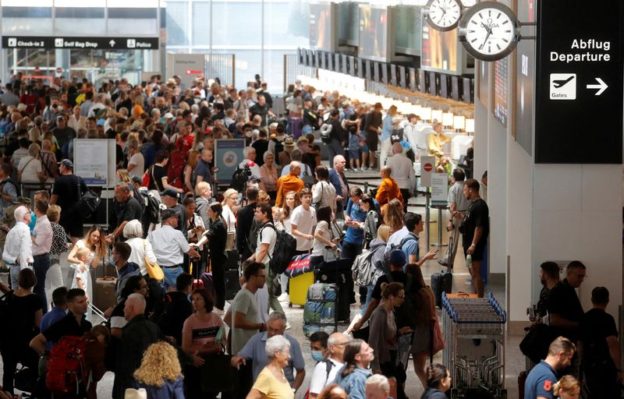Please try another search
Economy src hour ago (Jun 2src, 2022 src2:36AM ET)
© Reuters. FILE PHOTO: Passengers wait in front of check-in counters in a terminal at Zurich Airport, Switzerland June src5, 2022. REUTERS/Arnd Wiegmann
By Jamie Freed
DOHA (Reuters) -Pent-up demand from the pandemic means consumers are weathering high airfares, but as summer ends and inflation and interest rate rises begin to bite, there are growing questions over whether the appetite for travel is sustainable.
Global airlines are now expected to post a $9.7 billion loss in 2022, a sharp improvement from a revised $42.src billion loss in 202src, the International Air Transport Association (IATA) said on Monday, and to possibly claw their way back to profit in 2023.
But earnings remain well short of pre-pandemic levels as highly indebted carriers grapple with fresh challenges from rising fuel costs and high wages bills that they are attempting to pass on to consumers in the form of higher fares.
“We have a certain degree of insensitivity to prices this year,” IATA Chief Economist Marie Owens Thomsen said, citing high household savings rates during the pandemic and pent-up travel demand. “That could fade into next year.”
Industry leaders gathering at IATA’s annual meeting in Doha said bookings generally looked very strong for the next few months, but there was less certainty beyond that.
“The demand is pent up. It is revenge travel,” Malaysia Airlines Chief Executive Izham Ismail said. “Airfares have gone up tremendously. It is not only in Malaysia or Malaysia Airlines – it is throughout the industry globally. If the price continues to be high the demand will taper off.”
IATA forecasts yields, a proxy for airfares, will rise by 5.6% this year globally.
Air New Zealand Chief Executive Greg Foran said fares at his airline were now running 20% to 25% above pre-COVID levels, in part to cover fuel prices that have more than doubled.
“We are communicating to our customers and letting them know … what they’re seeing in ticket prices is not Air New Zealand trying to recover money that it lost over the last 800-plus days. It’s about dealing with cost pressures that we have in front of us today,” he said.
Consumers in many countries are now facing higher prices for everyday items such as groceries and gasoline that are rising faster than wages.
To date, that has not hit the appetite for travel, with many having saved up during the pandemic when many borders were closed and holidays were postponed.
Hawaiian Airlines Chief Executive Peter Ingram said demand from the U.S. mainland and Canada was “incredibly robust”, with capacity running around src5% above pre-pandemic levels.
“It’s impossible not to be aware of the fact that we’re seeing a lot of inflation in the United States. But as we look at the demand right now, we aren’t really seeing any effects,” he said. “That’s not to say we won’t see some as the year goes on. But right now, all the demand indicators are very strong.”
IATA Director General Willie Walsh also played down concerns of a so-called “demand cliff” that would spell a short-lived recovery.
“I don’t think it’s a flash in the pan,” he said. “I think there is some pent-up demand being fulfilled at the moment, but you’ve got to remember we’re still well below where we were in 20src9.”
“So I think there’s still a lot of ground to make up before we can get into the debate as to whether we’ll see that taper off.”
But in India, where airlines are entering a traditionally lower travel period in July to September during monsoon season, there are rising concerns about the sustainability of demand given airfares have not fully covered the impact of rising fuel prices, Vistara Chief Executive Vinod Kannan said.
“We have to cross our fingers, wish, pray and see what happens,” he said of the low season. “Fare increases can help you to a certain extent. But if your demand drops off, you’re back to square one.”
Related Articles

Comments are closed